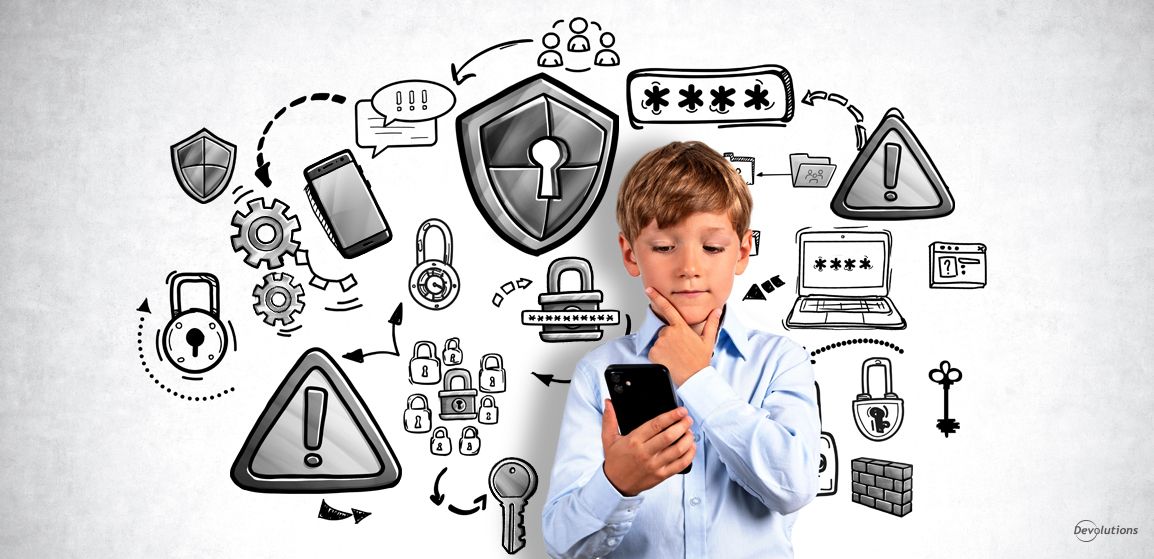In our part of the world, millions of kids recently headed back to school so they can learn the essentials for a successful career and life. But there is one subject that typically isn’t covered in the curriculum, yet definitely should be, given how important and consequential it has become: cybersecurity.
As part of our campaign to mark Cybersecurity Awareness Month in October, below we provide 7 tips to help parents teach their kids about staying safe online:
1. Explain what private information really is
The first thing that parents should do is help their kids understand what “private information” really is on today’s digital landscape. The list includes (but is not limited to) information such as their name, address, phone number, birthday, and details about their part-time job. To kids, these may be boring and harmless details. But to cyber criminals, they could be clues and keys that ultimately help them breach accounts, steal identities, and even establish credit histories on behalf of their unsuspecting young victims.
2. Review and set privacy settings
Parents need to review and configure the privacy settings for the various apps and programs on their kids' device. Keep in mind that some kids (particularly teens) aren’t going to be happy about what they see as a “outrageous, shameful and shocking” violation of their privacy. In that case, parents need to spend time with their kids to go over the privacy options and settings, and discuss why choices need to be made.
3. Explain that it’s usually impossible to take something off the web
When writing an essay or short story, kids can easily delete information that they aren’t happy with (like how, upon reflection, referring to Beethoven as “the dope goat sigma, periodt” might not be well received by their teacher). However, on social media, forums, and other places across the interwebs, kids need to understand that erasing something may be impossible. And even on sites where it is possible to delete a post, by that time the information would have been seen and could have been saved.
4. Teach them the risks of insecure Wi-Fi
The good news is that Wi-Fi hotspots are seemingly everywhere these days: coffee shops, restaurants, retail stores, and even in some outdoor spaces like parks and playgrounds. But the bad news is virtually all of these access points are insecure. Ideally, parents could just tell their kids that insecure Wi-Fi is off-limits. But practically, this is unlikely to work — especially if kids see all of their friends jumping online and expect to be part of the crowd. As such, the next-best thing for parents to do is circle back to tips 1, 2, and 3, and help their kids understand the extreme importance of protecting their private information.
Now, before moving on we need to briefly discuss a related topic: VPNs. Some parents may think that installing a credible VPN on their kids’ devices, and teaching them when and how to use it, is a good way to reduce the risks of using insecure Wi-Fi. There is some truth to this. However, there is also a big problem: kids who use a VPN will typically be able to circumvent restrictions imposed by legitimate insecure Wi-Fi access points, such as those provided by their school, library, or club. Parents who ultimately decide to install a VPN (and by the way: parents should choose and install a VPN — never their kids!), must also ensure that their kids use it properly.
5. Reward kids for keeping their devices safe
Parents can diligently teach their kids to be safe online, and kids can earnestly follow these instructions. Unfortunately, this may not matter if kids leave their device at the mall (or anywhere else) and it falls into the wrong hands. Parents should adopt two tactics here. First, they should regularly remind their kids to safeguard their device at all times, and never — ever! — leave it unattended; even for a few seconds. Second, they should reward their kids for being responsible and taking good care of their device (and other expensive or hard-to-replace items). Ample research has confirmed that positive reinforcement encourages good behavior in kids.
6. Explain the dangers of phishing
Cyber criminals are increasingly targeting kids with phishing campaigns (e.g., fake links and pop-up notifications that seem real and exciting). Some of the most popular hoaxes include: online shopping scams, fake contests, online quizzes, talent scouting scams, money transfer scams, online gaming scams, and “free” product scams. In addition, older teens who are preparing to graduate high school can find themselves targeted by enticing financial aid scams.
To deal with this, parents should clearly, carefully, and patiently help their kids understand what phishing campaigns are, and why they exist. Next, parents should increase the security on their kids' email account, so that all links are rendered inactive and attachments cannot be downloaded. If this is not feasible (e.g., their kid is working on a school, club, or other legitimate assignment that requires clicking links or downloading attachments), then parents should teach their kids how to recognize and avoid suspicious-looking links or attachments — or better yet, have them check in with a responsible adult before clicking anything.
7. Make learning about cybersecurity fun
The risks and consequences of identity theft are scary, and parents need to convey the seriousness – or else their kids are unlikely to perk up and pay attention. However, parents should also try and make learning about cybersecurity fun! There are several free online games that teach important cybersecurity lessons, yet in an entertaining and imaginative way. Some options include:
All of the above are generally suitable for younger children, although many teens — and for that matter, many adults! — will likely find the games informative, entertaining, and worthwhile. There are hundreds of cybersecurity games available (both free and paid versions). Parents should research different options to determine what will work best for their kids.
Bonus tip for parents: Dial back the “sharenting”
To wrap things up, we need to shift the focus from kids to parents.
Many parents enjoy sharing pics and videos of their kids across social media. And who can blame them? Kids are an endless source of special moments, once-in-a-lifetime milestones, and (especially younger ones) hysterical messes.
However, experts are urging parents to dial back on the “sharenting” (a term derived from “parenting” and “sharing” in a social media context). The impact can be quite negative if it makes kids more vulnerable to identity theft and harassment. And even if neither of these problems occur, over-sharing can undermine a child’s ability to tell their own story as they get older. Total strangers who they meet for the first time (online or in-person) may already know intimate or embarrassing details about them.
Now, does this mean that parents should completely stop posting pics and announcements of their kids' birthday parties, athletic feats, piano recitals, and so on? Not necessarily. Rather, it means that parents should be aware of the risks. The Cleveland Clinic recommends that parents answer these questions before posting anything that involves their child:
- What is the content?
- Why am I posting it?
- Who is my intended audience?
- Have I set my permissions accordingly?
- Is my child old enough to understand the concept of a digital footprint? If so, did get their consent? If not, do I feel that they would be happy to see this when they are older?
- Did I remove any identifying information?
- Could somebody potentially use this content to harm my child?
- Would I be upset to lose ownership of this content, or see the platform I post on use it for their own purposes?
- Am I sharing anything that would be inappropriate or embarrassing for a stranger, romantic partner, college admissions committee, or future employer to know about my child? Research has found that 90% of employers look at potential job candidates’ social media footprint, and 79% have rejected a candidate based on what they discovered.
And if there is any concern or doubt, then the advice is clear: don’t post it!
What’s your advice?
We hope that these tips help parents keep your kids safe online, both now and into the future. Now, let’s pass the microphone over to you!
What have you tried with your kids that has worked, and what hasn’t? What rules do you have in place? What do you think are the greatest threats targeting kids?
Please comment below. Being a parent is tough (especially these days!), and we can all benefit from your advice, experience, and wisdom.





